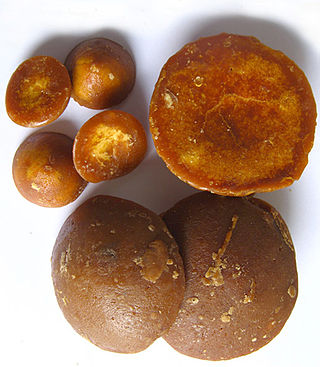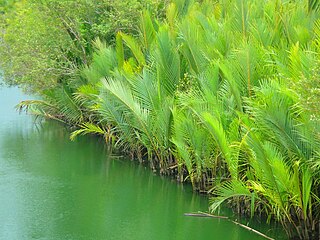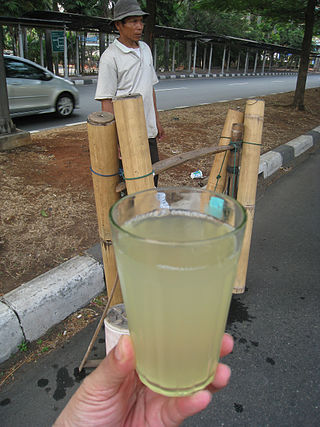
Vinegar is an aqueous solution of acetic acid and trace compounds that may include flavorings. Vinegar typically contains from 5% to 8% acetic acid by volume. Usually, the acetic acid is produced by a double fermentation, converting simple sugars to ethanol using yeast, and ethanol to acetic acid using acetic acid bacteria. Many types of vinegar are made, depending on source materials. The product is now mainly used in the culinary arts as a flavorful, acidic cooking ingredient, or in pickling. Various types are used as condiments or garnishes, including balsamic vinegar and malt vinegar.

Palm wine, known by several local names, is an alcoholic beverage created from the sap of various species of palm tree such as the palmyra, date palms, and coconut palms. It is known by various names in different regions and is common in various parts of Africa, the Caribbean, South America, South Asia, Southeast Asia and Micronesia.

Feni is a spiritous liquor type originating in Goa, India. The two most popular types of feni are cashew feni and coconut feni. Depending on the ingredients; however, other varieties and newer blends are also sold by distilleries. The small-batch distillation of feni has a fundamental effect on its final character, which still retains some of the delicate aromatics, congeners, and flavour elements of the juice from which it is produced.

Arrack is a distilled alcoholic drink typically produced in India, Sri Lanka and Southeast Asia, made from the fermented sap of coconut flowers or sugarcane, and also with grain or fruit depending upon the country of origin. It is sometimes spelled arak, or simply referred to as 'rack or 'rak. It is not to be confused with the anise-flavored distilled spirit called arak or araq. In many parts of India arrack is colloquially known as "desi daru".

The generic term for condiments in the Filipino cuisine is sawsawan. Unlike sauces in other Southeast Asian regions, most sawsawan are not prepared beforehand, but are assembled on the table according to the preferences of the diner.

Palm sugar is a sweetener derived from any variety of palm tree. Palm sugar is sometimes qualified by the type of palm, as in coconut palm sugar. While sugars from different palms may have slightly different compositions, all are processed similarly and can be used interchangeably.

Arenga pinnata is an economically important feather palm native to tropical Asia, from eastern India east to Malaysia, Indonesia, and the Philippines in the east. Common names include sugar palm, areng palm, black sugar palm, and kaong palm, among other names.
Lambanóg is a traditional Filipino distilled coconut palm liquor. It is derived from tubâ made from coconut sap that has been aged for at least 48 hours. It originates from Luzon and the Visayas Islands. During the Spanish colonial period, it was also known as vino de coco in Spanish. It is also commonly described as "coconut vodka" due to its clear to milky white color and high alcohol content. It is particularly potent, having a typical alcohol content of 80 to 90 proof after a single distillation; this may go as high as 166 proof after the second distillation.

Coconut sugar is a palm sugar produced from the sap of the flower bud stem of the coconut palm.

Nypa fruticans, commonly known as the nipa palm or mangrove palm, is a species of palm native to the coastlines and estuarine habitats of the Indian and Pacific Oceans. It is the only palm considered adapted to the mangrove biome. The genus Nypa and the subfamily Nypoideae are monotypic taxa because this species is their only member.
Bahalina, sometimes called "coconut red wine", is a traditional Filipino palm wine made from fermented coconut or nipa palm sap. It is derived from tubâ that has been aged for several months to several years. It originates from the Visayas and Mindanao islands of the southern Philippines. It is deep brown-orange in color and has a slightly bitter astringent taste.

Philippine wine or Filipino wine are various wines produced in the Philippines. They include indigenous wines fermented from palm sap, rice, job's tears, sugarcane, and honey; as well as modern wines mostly produced from various fruit crops.

Lahang is a traditional sweet and cold beverage from West Java, Indonesia, made from the sap of Arenga pinnata. The drink is commonly known in Indonesia; however, it is usually associated with the Sundanese of West Java. It is known as a traditional isotonic drink.
Palm vinegar or sugar palm vinegar refers to vinegar made from palm or sugar palm sap:

Nipa palm vinegar, also known as sukang sasâ or sukang nipa, is a traditional Filipino vinegar made from the sap of the nipa palm. It is one of the four main types of vinegars in the Philippines, along with coconut vinegar, cane vinegar, and kaong palm vinegar. It is usually sold under the generic label of "palm vinegar".

Tubâ is a Filipino alcoholic beverage created from the sap of various species of palm trees. During the Spanish colonial period, tubâ was introduced to Guam, the Marianas, and Mexico via the Manila Galleons. It remains popular in Mexico, especially in the states of Colima, Jalisco, Michoacán, Nayarit, and Guerrero. Tubâ was also introduced to the Torres Strait Islands of Australia in the mid-19th century by Filipino immigrant workers in the pearling industry.
Agkud is a traditional Filipino fermented rice paste or rice wine of the Manobo people from Bukidnon. Agkud specifically refers to fermented three-day-old paste made with rice, ginger, sugarcane juice, and agonan or tapey. The rice wine pangasi is made from agkud except fermented longer for at least one month. Modern versions of the agkud can use other sources of starch like cassava, sorghum, or corn. Hot peppers may also be used instead of ginger. Agkud is drunk during celebrations, rituals, and various social events.

Spiced vinegar is a type of Philippine vinegar condiment that is made of vinegar e.g. fermented coconut sap infused with spices primarily bird's eye chili and garlic.
Laksoy, is a traditional Filipino distilled nipa palm liquor. It is derived from tubâ made from nipa palm sap that has been aged for at least 48 hours. It originates from Eastern Mindanao, the Visayas Islands, and the Bicol Region. During the Spanish colonial period, it was also known as vino de nipa in Spanish. Like the lambanog, it is particularly potent, having a typical alcohol content of 70 to 100 proof after a single distillation.
















